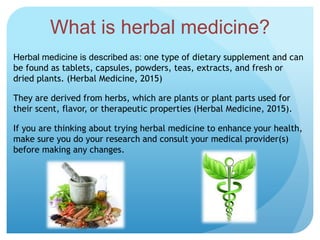3 Easy Facts About Herbalife Shown
3 Easy Facts About Herbalife Shown
Blog Article
The Herbalife Statements
Table of ContentsThe Definitive Guide to Herbalife4 Easy Facts About Herbalife Described8 Simple Techniques For HerbalifeLittle Known Questions About Herbalife.

In 1990, expense related to "alternative" treatment in the USA was estimated to be US$ 13.7 billion. This had actually doubled by the year 1997, with organic medications expanding quicker than any kind of various other alternate therapy (Eisenberg et al. 1998). In Australia, copyright, and the United Kingdom, annual expense on standard medicine is estimated to be US$ 80 million, US$ 1 billion, and US$ 2.3 billion, specifically.
The complete industrial value of the ethnobotanicals market can not be overlooked. In 1995, the complete turn over of nonprescription-bound herbal medications in drug stores was equivalent to nearly 30% of the overall turnover of nonprescription-bound medicines in Germany, and in the United States, the yearly retail sales of organic products was estimated to be US$ 5 - herbalife.1 billion.
Our Herbalife Diaries
In China, the overall worth of organic medicine manufactured in 1995 got to 17.6 billion Chinese yuan (about US$ 2.5 billion; Eisenberg et al. 1998; WHO 2001). This trend has proceeded, and annual profits in Western Europe got to US$ 5 billion in 2003-2004 (De Smet 2005). In China, sales of natural products totaled US$ 14 billion in 2005, and income from natural medicines in Brazil was US$ 160 million in 2007 (World Health Company; http://www.who.int/topics/traditional_medicine/en/). In China, in 2003, typical natural medicines played a noticeable role in the strategy to contain and treat severe acute respiratory disorder (SARS), and in Africa, a typical natural medication, the Africa flower, has been utilized for decades to treat throwing away symptoms connected with HIV (De Smet 2005; Tilburt and Kaptchuk 2008).
Natural herbs and plants can be processed and can be absorbed various ways and kinds, and they include the whole herb, teas, syrup, crucial oils, ointments, salves, rubs, pills, and tablet computers which contain a ground or powdered type of a raw herb or its dried extract. Plants and herbs essence vary in the solvent made use of for removal, temperature level, and extraction time, and consist of alcoholic removes (casts), vinegars (acetic acid removes), warm water remove (tisanes), long-lasting boiled extract, typically origins or bark (preparations), and cold infusion of plants (macerates).

Around 200 years earlier, the first pharmacologically active pure substance, morphine, was generated from opium drawn out from seeds vessels of the poppy Papaver somniferum. This exploration showed that medicines from plants can be purified and carried out in specific does no matter of the source or age of the material (Rousseaux and Schachter 2003; Hartmann 2007).
How Herbalife can Save You Time, Stress, and Money.
With this continued trend, products from plants and natural sources (such as fungi and aquatic microbes) or analogs inspired by them have actually added considerably to the commercial medicine preparations today. Instances consist of prescription antibiotics (e.g., penicillin, erythromycin); the cardiac energizer digoxin from foxglove (Digitalis purpurea); salicylic acid, a precursor of aspirin, originated from willow bark (Salix spp.); reserpine, an antipsychotic and antihypertensive drug from Rauwolfia spp.; and antimalarials such as quinine from Cinchona bark and lipid-lowering agents (e.g., lovastatin) from a fungus (Rishton 2008; Schmidt et al.
Additionally, even more than 60% of cancer cells therapies on the marketplace or in screening are based upon all-natural items. Of 177 medications accepted around the world for therapy of cancer cells, even more than 70% are based upon all-natural items or mimetics, several of which are improved with combinatorial chemistry. Cancer therapeutics from plants consist of paclitaxel, separated from the Pacific yew tree; camptothecin, stemmed from the Chinese "pleased tree" Camptotheca acuminata and used to prepare irinotecan and topotecan; and combretastatin, stemmed from the South African bush willow (Brower 2008.
2010). Between 2005 and 2007, 13 medications stemmed from all-natural products were accepted in the United States. Even more than 100 natural product-based medicines remain in professional studies (Li and Vederas 2009), and of the complete 252 medicines in the World Health Organization's (WHO) crucial medication list, link 11% are solely of plant beginning (Sahoo et al.
WHO has actually identified the vital contribution of traditional medication to give important treatment (Globe Wellness Organization, http://www.who.int/topics/traditional_medicine/en/. In 1989, the united state Congress established the Workplace of Natural Medicine within the National Institutes of Wellness to encourage clinical study in the field of conventional medicine (http://nccam.nih.gov, last access: November 5, 2010), and the European Scientific Cooperative on Phytotherapy (ESCOP) was founded in 1989 with the objective of progressing the scientific standing and harmonization of phytomedicines at the European degree (www.escop.com, last accessibility: November 5, 2010).
An Unbiased View of Herbalife
In the USA, the National Facility for Complementary and Natural Medicine at the National Institutes of Wellness invested around US$ 33 million on organic medicines in the 2005; in 2004, the National Canadian Institute devoted almost US$ 89 million for examining a variety of standard therapies. While this scale of investment is reduced compared to the complete r & d expenses of the pharmaceutical sector, it nevertheless shows real public, industry, and governmental rate of interest in this field (Li and Vederas 2009). With remarkable expansion in the interest in and use conventional medicines worldwide, two major areas of concern arise that bring major difficulties.

Report this page